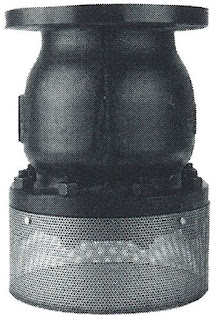 |
| Float and Thermostatic Steam Trap Courtesy Colton Industries |
Steam based heating relies on the delivery of the latent heat of the steam to a heat exchanger or piece of utilization equipment. Once the latent heat is delivered, condensate (basically hot water) forms. The condensate contains no latent heat and provides comparatively little value as a heat source. Utilization equipment and heat exchangers have their performance predicated upon a supply of steam, not hot water. A properly selected steam trap will remove condensate across a range of steam utilization rates, keeping the system operating at the rated capacity.
The steam trap routes the condensate out of the steam containing portion of the system, often on a return trip to the boiler. Cycling the condensate back through the system for re-boiling contributes greatly to steam system energy efficiency. Condensate removal is accomplished with a float. Non-condensible gases are vented through a thermostatically controlled port on the unit.
More details on steam traps are included below. Share your steam system challenges with a product specialist, combining your facility and process knowledge with their product application expertise to develop effective solutions.
